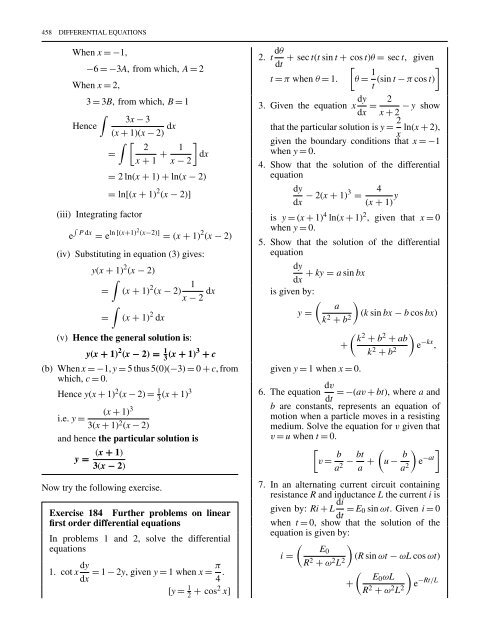differential equation
You also want an ePaper? Increase the reach of your titles
YUMPU automatically turns print PDFs into web optimized ePapers that Google loves.
458 DIFFERENTIAL EQUATIONS<br />
When x =−1,<br />
−6 =−3A, from which, A = 2<br />
When x = 2,<br />
3 = 3B, from which, B = 1<br />
∫<br />
3x − 3<br />
Hence<br />
(x + 1)(x − 2) dx<br />
∫ [ 2<br />
=<br />
x + 1 + 1 ]<br />
dx<br />
x − 2<br />
(iii) Integrating factor<br />
= 2ln(x + 1) + ln(x − 2)<br />
= ln[(x + 1) 2 (x − 2)]<br />
e∫<br />
P dx<br />
= e ln [(x+1)2 (x−2)] = (x + 1) 2 (x − 2)<br />
(iv) Substituting in <strong>equation</strong> (3) gives:<br />
y(x + 1) 2 (x − 2)<br />
∫<br />
= (x + 1) 2 1<br />
(x − 2)<br />
x − 2 dx<br />
∫<br />
= (x + 1) 2 dx<br />
(v) Hence the general solution is:<br />
y(x + 1) 2 (x − 2) = 1 3 (x + 1)3 + c<br />
(b) When x =−1, y = 5 thus 5(0)(−3) = 0 + c, from<br />
which, c = 0.<br />
Hence y(x + 1) 2 (x − 2) = 1 3<br />
(x + 1)3<br />
(x + 1) 3<br />
i.e. y =<br />
3(x + 1) 2 (x − 2)<br />
and hence the particular solution is<br />
y =<br />
(x + 1)<br />
3(x − 2)<br />
Now try the following exercise.<br />
Exercise 184 Further problems on linear<br />
first order <strong>differential</strong> <strong>equation</strong>s<br />
In problems 1 and 2, solve the <strong>differential</strong><br />
<strong>equation</strong>s<br />
1. cot x dy<br />
dx = 1 − 2y,giveny = 1 when x = π 4 .<br />
[y = 1 2 + cos2 x]<br />
2. t dθ + sec t(t sin t + cos t)θ = sec t, given<br />
dt<br />
t = π when θ = 1.<br />
[θ = 1 ]<br />
t (sin t − π cos t)<br />
3. Given the <strong>equation</strong> x dy<br />
dx = 2<br />
x + 2 − y show<br />
that the particular solution is y = 2 ln(x + 2),<br />
x<br />
given the boundary conditions that x =−1<br />
when y = 0.<br />
4. Show that the solution of the <strong>differential</strong><br />
<strong>equation</strong><br />
dy<br />
dx − 2(x + 1)3 =<br />
4<br />
(x + 1) y<br />
is y = (x + 1) 4 ln(x + 1) 2 , given that x = 0<br />
when y = 0.<br />
5. Show that the solution of the <strong>differential</strong><br />
<strong>equation</strong><br />
dy<br />
+ ky = a sin bx<br />
dx<br />
is given by:<br />
(<br />
y =<br />
given y = 1 when x = 0.<br />
)<br />
a<br />
k 2 + b 2 (k sin bx − b cos bx)<br />
( k 2 + b 2 )<br />
+ ab<br />
+<br />
k 2 + b 2 e −kx ,<br />
6. The <strong>equation</strong> dv =−(av + bt), where a and<br />
dt<br />
b are constants, represents an <strong>equation</strong> of<br />
motion when a particle moves in a resisting<br />
medium. Solve the <strong>equation</strong> for v given that<br />
v = u when t = 0.<br />
[<br />
v = b a 2 − bt (<br />
a + u − b ) ]<br />
a 2 e −at<br />
7. In an alternating current circuit containing<br />
resistance R and inductance L the current i is<br />
given by: Ri + L di<br />
dt = E 0 sin ωt. Giveni = 0<br />
when t = 0, show that the solution of the<br />
<strong>equation</strong> is given by:<br />
(<br />
i =<br />
)<br />
E 0<br />
R 2 + ω 2 L 2 (R sin ωt − ωL cos ωt)<br />
( )<br />
E0 ωL<br />
+<br />
R 2 + ω 2 L 2 e −Rt/L










